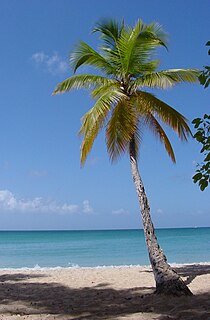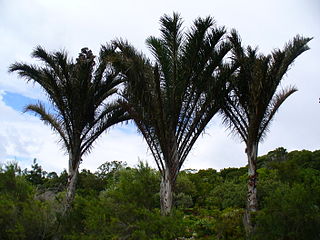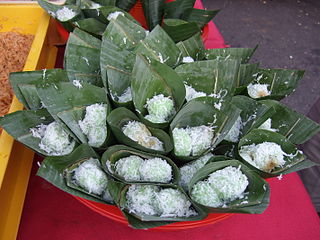Sugar palm is a common name for several species of palms used to produce sugar.

The Arecaceae are a botanical family of perennial plants. Their growth form can be climbers, shrubs, trees and stemless plants, all commonly known as palms. Those having a tree form are colloquially called palm trees. They are flowering plants, a family in the monocot order Arecales. Currently 181 genera with around 2600 species are known, most of them restricted to tropical and subtropical climates. Most palms are distinguished by their large, compound, evergreen leaves, known as fronds, arranged at the top of an unbranched stem. However, palms exhibit an enormous diversity in physical characteristics and inhabit nearly every type of habitat within their range, from rainforests to deserts.

Sugar is the generic name for sweet-tasting, soluble carbohydrates, many of which are used in food. The various types of sugar are derived from different sources. Simple sugars are called monosaccharides and include glucose, fructose, and galactose. "Table sugar" or "granulated sugar" refers to sucrose, a disaccharide of glucose and fructose. In the body, sucrose is hydrolysed into fructose and glucose.
- Species used include:
- Arenga pinnata (syn. A. saccharifera)
- Borassus flabellifer
- Caryota urens
- Cocos nucifera

Arenga pinnata is an economically important feather palm native to tropical Asia, from eastern India east to Malaysia, Indonesia, and the Philippines in the east. Common names include sugar palm, areng palm, black sugar palm, and kaong palm, among other names.

Borassus flabellifer, commonly known as doub palm, palmyra palm, tala palm, toddy palm, wine palm, or ice apple is native to the Indian subcontinent and Southeast Asia, including Nepal, India, Bangladesh, Sri Lanka, Cambodia, Laos, Burma, Thailand, Vietnam, Malaysia, Indonesia and the Philippines. It is reportedly naturalized in Pakistan, Socotra, and parts of China.

Caryota urens is a species of flowering plant in the palm family from the Indian Subcontinent and Southeast Asia where they grow in fields and rainforest clearings. The epithet urens is Latin for "stinging" alluding to the chemicals in the fruit. They are commonly called solitary fishtail palm, toddy palm, wine palm, jaggery palm. කිතුල් - Kithul in Sinhala,ต้นเต่าร้าง in Thai, கூந்தற்பனை - Koonthal Panai in Tamil, ಬೈನೆ ಮರ in Kannada, ചൂണ്ടപ്പന - Choondappana in Malayalam চাউর in Bengali,. Its leaf is used as fishing rod after trimming the branches of the leaf and drying. According to Monier-Williams, it is called moha-karin in Sanskrit. It is one of the sugar palms.










